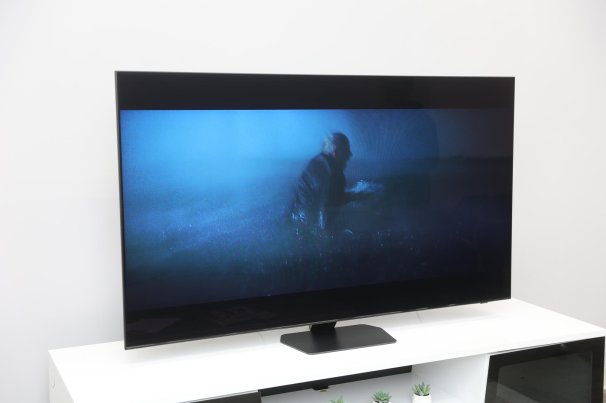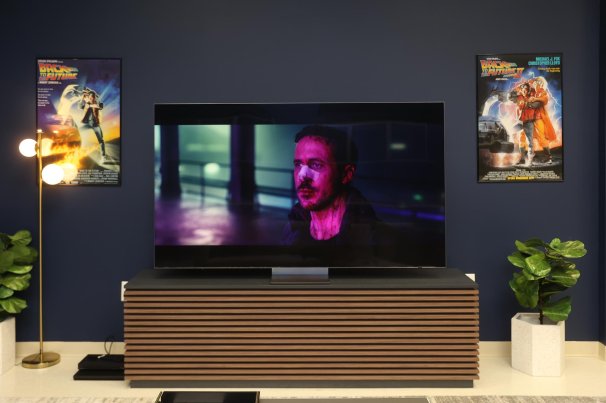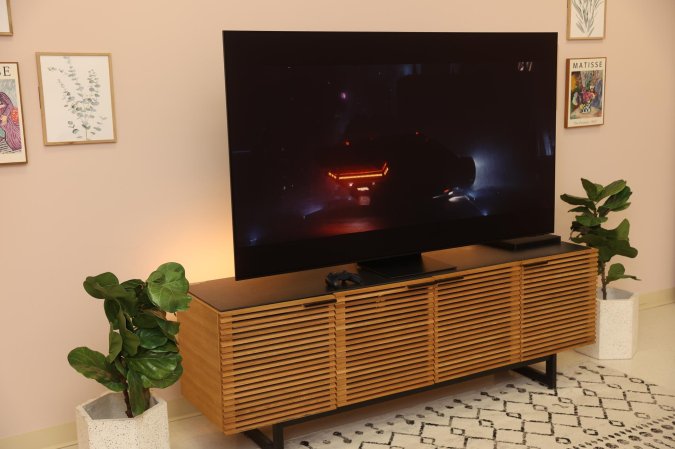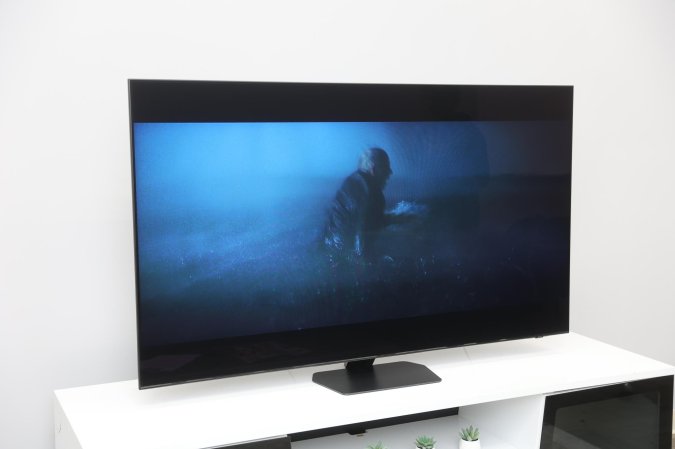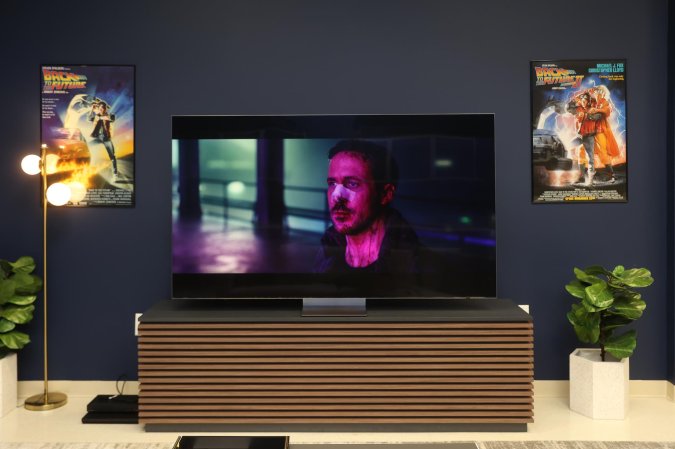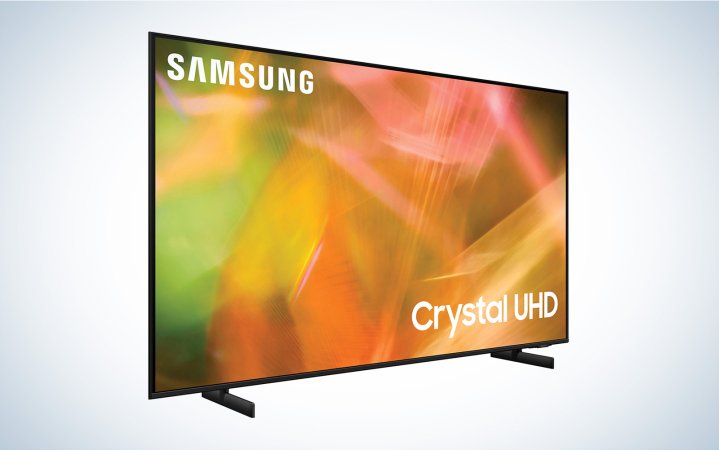We may earn revenue from the products available on this page and participate in affiliate programs. Learn more ›
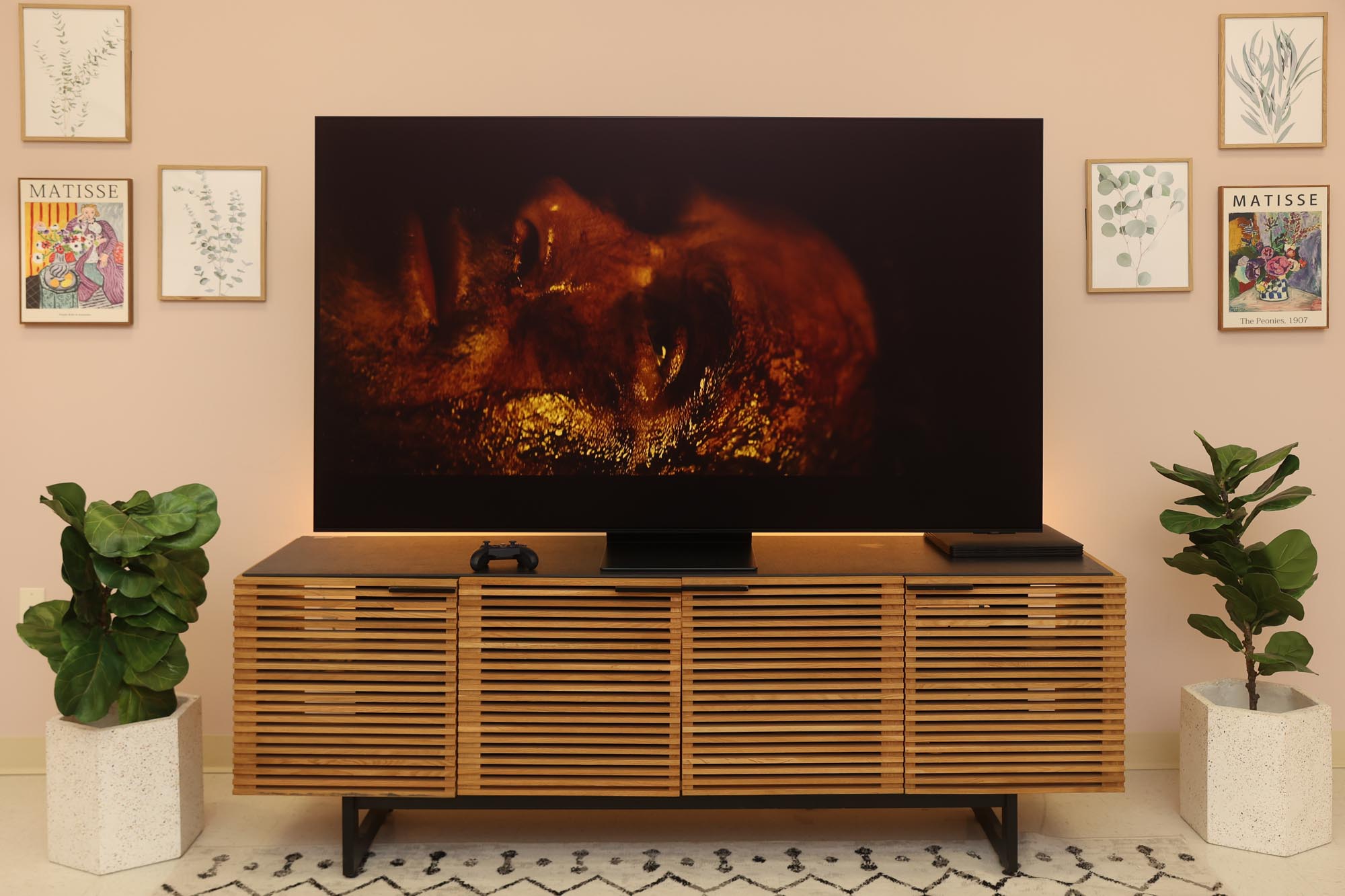
Samsung TVs represent an enormous chunk of the modern market, and for good reason. The company offers a TV for just about any space or budget. That includes everything from high-end OLED models down to budget-friendly LED displays. We’ve chosen the Samsung S95D OLED as the best overall Samsung TV for its exceptional color, brightness, and ability to fight glare, but the list doesn’t end at the high-end. Read on for the perfect set, no matter your space or budget.
- Best overall: Samsung S95D OLED 4K Smart TV
- Best QLED: QN90D Neo QLED 4K TV
- Best 8K: QN900D Neo QLED 8K TV
- Best outdoor: Samsung The Terrace Partial Sun Outdoor QLED 4K Smart TV
- Best for interior design: Samsung The Frame QLED HDR Smart TV
- Best budget: Samsung AU8000 Crystal UHD Smart TV
How we chose the best Samsung TVs
I have reviewed home theater gear (and gadgets of almost every kind) for nearly two decades. I was the digital editor at Sound & Vision for several years and have extensively covered TV and TV tech for PopSci.com and other publications. I typically rely on a PlayStation 5 with top-tier titles installed and a 4K Blu-ray player to get a feel for what these TVs can really do. To complete the research, I surveyed Samsung’s full lineup while comparing specs, reading customer reviews, and considering editorial opinions from colleagues at other publications.
The best Samsung TVs: Reviews & Recommendations
From flagships to more achievable flatscreens, I’ve drawn from my own personal experience watching, testing, and reviewing to bring you the standout 2024 models from Samsung.
Best overall: Samsung S95D OLED 4K Smart TV
Specs
- Sizes: 55”, 65”, and 77”
- Resolution: 4K
- Refresh rate: 120Hz native (up to 144Hz in some situations)
- HDMI ports: 4
Pros
- Spectacular picture
- Exceptional glare-resistance
- Very bright for an OLED
- Ports live on a box connected by a wire to make installation more flexible
- Super-thin bezel and panel
- Immaculate color
Cons
- Expensive
- Limited sizes
This is one of the best TVs I have ever reviewed. OLEDs typically struggle in bright rooms because they lack the brute force brightness needed to overpower ambient light. Samsung has taken a two-pronged approach to fixing that with this TV. First, Quantum Dot tech helps boost the overall brightness to levels that rival more typical QLED displays. On full brightness, this TV is actually a little too bright in a dark room. That’s a good thing. Additionally, Samsung has added a truly effective anti-glare coating to the front of the screen. During our testing, we shined a light bulb directly onto the screen from just a few feet away, and the anti-glare coating simply diffused the light and maintained the picture’s overall contrast. It’s really impressive.
Underneath that anti-glare coating, Samsung loaded this TV with all its current bells and whistles. You get a variety of picture modes (including Filmmaker Mode, which I still prefer for most situations) and the built-in gaming hub that allows for console-free gaming. As you’d expect from an OLED, this TV offers tons of contrast and impeccable color under pretty much any conditions.
Some OLEDs aren’t ideal for gaming due to input lag, but that’s not a problem with this set. The suite of four HDMI 2.1 ports also makes it simple to attach a modern gaming console and get the most out of it.
This is a high-end TV, so it offers a high-end suite of features, including a 120Hz refresh rate, which can go up to 144Hz when using a PC input. It has four current-gen HDMI ports, all of which live on a box connected via a wire, so it’s flexible in terms of installation.
Samsung may not make many OLED TVs, but this one is absolutely a winner.
Best QLED: QN90D Neo QLED 4K TV
Specs
- Sizes: 43”, 50”, 55”, 65”, 75”, 85”, and 98″
- Resolution: 4K
- Refresh rate: 120Hz
- HDMI ports: 4
Pros
- Excellent overall image quality
- Bright
- Anti-reflective coating improves performance in bright rooms
- Tons of sizes available
- AI-powered upscaling works very well
Cons
- Inputs live on the back of the TV instead of in a connected box
- Sound is just OK
The OLED price tag will be understandably prohibitive for many people, but Samsung’s Neo QLED offerings offer similar performance for less money, making it a best value. The Neo QLED displays employ Mini-LED backlighting. By shrinking the backlights, Samsung can be more precise about where the illumination lies underneath the screen. That allows the dark areas to stay, well, dark without looking washed out and gray.
Samsung has given this TV a full suite of high-end features, including four HDMI 2.1 ports, but they’re oddly placed on the back of the TV instead of on a separate “One Connect” box, which the flagships get. This is a departure from last year’s version of the same model and might feel like a slight downgrade if you wanted that flexibility during installation.
When it comes to performance, however, there’s no downgrade in effect. As you’d expect from a Quantum Dot TV, the Q90D is bright and extremely vibrant. I typically only use game mode and Samsung’s Filmmaker Mode, which slightly tones down the colors to match the source material more closely and is a quick fix when you don’t want to go deep into calibration.
I fired up some scenes from Godzilla Vs. Kong on 4K Blu-ray as part of my testing. The contrast ratio had no problem rendering detail, even in dark scenes. The fast action scenes stayed together nicely without ugly artifacts or motion issues.
This is a high-end TV, and it offers all the features you’d expect to go along with that. If you’re willing to spend more than what the Crystal-Series TVs cost but don’t want to go all the way to the OLED level, this is a fantastic option.
Best 8K: QN900D Neo QLED 8K TV
Specs
- Sizes: 65”, 75”, and 85”
- Resolution: 8K
- Refresh rate: 120Hz (up to 144Hz in some situations)
- HDMI ports: 4
Pros
- It has the most resolution, so it’s as futureproof as TVs get right now
- Exceptional upscaling
- Excellent picture quality
- Ports live on an external box
- Very slim
- Anti-reflective coating fights glare
Cons
- You’re paying for 8K when there’s almost no native 8K content
Native 8K content isn’t here yet, but it is coming down the road, so if you want a relatively future-proof TV, this is your pick—the screen resolution checks in at a massive 33 megapixels. Since there’s almost nothing in that resolution, you will rely on the TV to upscale your content. Luckily, Samsung put a ton of processing power into the QN900D for just that purpose.
I hooked up my PS5 to the review unit and played a 4K Blu-ray of Blade Runner 2049 to see how the panel would hold up to a lot of fast motion, high contrast, and fine detail moving around the screen. That action can play havoc on a picture in its native resolution, but the Samsung handled it with aplomb, even while upscaling. The colors are bright, the action smooth, and I didn’t notice an appreciable downgrade in the image when standing a few feet away.
This is an expensive, high-end TV, so it comes with the bells and whistles you’d expect. It offers four HDMI 2.1 ports (essential for 8K content) and the Samsung One Connect box to house all connections.
I would typically always use external audio gear with a TV like this (like one of our top soundbars, including the Samsung HW-Q990D), but I was pleasantly surprised by the built-in speaker system. It creates a fairly powerful sound stage with noticeable surround effects from the Dolby Atmos tech inside.
That sound performance is especially impressive, considering how thin and sleek the panel is. I’m used to skinny TVs by now, but this nearly bezel-free design is really striking when you first see it.
Do you absolutely need to step up to this 8K model yet? No, but if you have the means and want something that will look great for years to come, this is the best splurge.
Best outdoor: Samsung The Terrace Partial Sun Outdoor QLED 4K Smart TV
Specs
- Sizes: 55”, 65”, and 75”
- Resolution: 4K
- Refresh rate: 60Hz
- HDMI ports: 3
Pros
- It can stand up to the elements
- Bright enough to be seen even with outdoor light
- 4K resolution is an upgrade for outdoor TVs
- Tap-to-mirror content from your phone
- Quantum dots provide excellent brightness and color
Cons
- Expensive
- The version meant for full-sun exposure costs $10,000
Most TVs aren’t meant to exist outside, even in a covered area. Moisture and dust can quickly cause all kinds of problems. And even indirect sunlight can cause enough glare to make the picture nearly impossible to see. The Terrace TV remedies those issues because it’s built for the outdoors.
The Terrace boasts an IP55 (Ingress Protection) rating, which means it’s rugged enough to survive moisture, dust, and even some of the light impacts that may come with typical outdoor wear and tear. Because it’s hard to keep a streaming box or gaming console outside, the Terrace allows users to tap their phones on the screen to start mirroring the content they’re watching. That’s in addition to the smart TV tech already built into the TV itself.
Despite its ruggedness, the Terrace also provides solid picture performance. It maxes out at 2,000 nits of brightness. To put that into perspective, the iPhone 14 typically runs at 800 nits with a 1,200-nit maximum. The Terrace isn’t always turned up to max, however. Samsung’s dynamic brightness automatically adjusts the picture to match your surroundings. Combined with the impressively effective anti-reflective coating, this TV looks surprisingly great for an outdoor display.
Note, though, that it’s not meant to be fully exposed to the sun all day. Samsung does make a version that can stand up to full-sun punishment, but it’ll cost you a cool $10,000.
Best for interior design: Samsung The Frame QLED HDR Smart TV
Specs
- Sizes: 32”
- Resolution: 1080p
- Refresh rate: 60Hz
- HDMI ports: 2
Pros
- Unmatched anti-reflective coating
- Ports live on a connected box
- Frame options make it actually look like art
- Art library lets you change up the look of your space
Cons
- It’s not meant to be a main TV
- Only two HDMI ports
- 1080p resolution is low for content, but good for art
Samsung’s Frame-series TV looks even more like a piece of art than ever before. This 32-inch TV isn’t massive and doesn’t offer a cutting-edge 4K or 8K resolution. However, it offers a very vibrant picture and one of the most impressive anti-glare screens I have ever seen. The matte surface refuses to show glare or let ambient light ruin its contrast.
You only get two HDMI ports and 1080p resolution, but at 32 inches, that’s also not a huge deal breaker. This is a relatively small TV by modern standards, so the relative lack of pixels shouldn’t be too huge a deal.
When you’re not streaming content, the TV can display a wide variety of art from your collection or the Samsung online store. The TV frame looks, well, like an actual frame and grants users tons of aesthetic options for blending it into any decor. Looking for more resolution and larger screen sizes (and willing to pay a larger price)? Check out the 4K LSO3D models.
Best budget: Samsung AU8000 Crystal UHD Smart TV
Specs
- Sizes: 55”, 65”, and 85”
- Resolution: 4K
- Refresh rate: 60Hz
- HDMI ports: 3
Pros
- Affordable
- Solid picture for the price
- Maxes out at a huge 85 inches
- Still includes useful features like Filmmaker Mode for accurate color
Cons
- Picture quality can’t stand up to upgraded models
- Only three HDMI ports
If you’ve been to a big box electronics store (or Sam’s Club) in the past year or two, you’ve probably seen this TV on display already. This is Samsung’s base-level TV offering that doesn’t include Quantum Dot tech but instead relies on a more typical backlight system.
There are some advantages to buying a TV at this level. The 85-inch version regularly goes on sale for around $1,300. Because it’s a Samsung smart TV, that also gets you native streaming capabilities. That’s a ton of TV for a very reasonable price.
There are some trade-offs, however. It offers a relatively low refresh rate and only comes equipped with three HDMI ports. If you’re just buying this TV to stream movies and TV shows, that should never really even come into play. But, if you’re looking for a killer gaming TV or silky smooth sports action, there are better (but more expensive) options out there.
Even as a base model, the AU8000 offers solid picture performance, especially with a little tweaking. They tend to come out of the box too bright and aggressively sharpened. With a little tweaking, it’s possible to get very solid performance.
Things to consider when shopping for the best Samsung TVs
You can take our word for the specific models we recommend, or you can go out into the aisles yourselves. Here are some things to look for so you get the TV that’s right for you:
Backlight type
Backlight technology is the most complicated part of the Samsung puzzle. In fact, it’s one of the trickiest parts of picking a TV in general right now. Here are Samsung’s backlight technologies unpacked:
LED: Light-emitting diodes are the stock way to illuminate a TV, and this is what you’ll find in Samsung’s most affordable TVs in the Crystal UHD series. LEDs behind the display shine through an LCD panel with colored filters to create an image. It’s a familiar tech that works well but can have issues of light showing up where it shouldn’t and harming contrast ratios.
QLED: Samsung took typical LED backlighting and added Quantum Dots into the equation. Quantum Dots emit light when current is applied, which makes QLED TVs some of the brightest and most vibrant around. QLEDs have represented the meatiest part of Samsung’s lineup for years now.
Neo QLED: Mini LEDs offer these higher-end displays more control over the parts of the screen that get illumination. These panels have more granular control over their backlighting, which leads to more contrast and less blooming and light leaks. While these are more expensive than the typical QLEDs, they offer a noticeable uptick in overall performance.
OLED: This stands for Organic Light-Emitting Diode, and it means each pixel in the display provides its own light. This enables unmatched contrast thanks to the fact that pixels can turn completely off when not needed. There’s no chance a backlight will leak through the panel and cause blooming or other unwanted effects. Samsung’s flagship OLED is actually a QD-OLED, which merges Quantum Dots with OLED to address OLED’s typical lack of brightness. Samsung has a traditional OLED with a more affordable price coming down the line in 2023, but we haven’t had a chance to see it or get official pricing yet.
Resolution
Currently, 8K TVs have almost no native content to take advantage of all those pixels. That makes 4K the default TV resolution at this time. If you want to step up to 8K, you’re going to pay a lot of money, and it’s going to be quite a while before you have native content to watch on it. Even then, the streaming services likely won’t hit 8K for quite some time. We recommend going 4K and playing it safe unless you really want to show off. And even then, it will only impress nerds like us. We appreciate the gesture, but save yourself some cash.
Refresh rate
Your TV must refresh its on-screen image many times per second to fool your eyes into thinking they see continuous motion. The more times the screen refreshes, the smoother the motion looks … to a point. Most Samsung TVs we recommend max out at 120Hz, which means the on-screen image refreshes up to 120 times. That fast refresh rate is great for things like current-gen console gaming and sometimes watching sports. Some more basic TVs top out at 60Hz, which will actually be just fine if you’re mostly planning to watch movies or streaming content.
Connectivity
Samsung smart TVs run on the company’s relatively robust Tizen smart TV platform, so you may not need to plug many devices into your TV. But we still recommend getting as many HDMI ports as you can manage. Most TVs on the list have four. That may sound like a lot, but you’ll likely hook a soundbar up to one, a gaming system up to another, and perhaps a streaming box. They can fill up quickly.
FAQs
The answer to whether QLED or OLED is better depends on your needs. QLED typically offers a brighter picture that’s easier to see in a room with a lot of ambient light. QLEDs are also almost always cheaper than OLEDs. Typical OLEDs, on the other hand, offer exceptional contrast and color but can’t match QLED’s brightness. Samsung’s S95D, however, integrates Quantum Dots to jack up the brightness of its flagship OLED without compromising on the color, plus an anti-reflective coating that really works. That’s why it landed the top spot on this list.
There used to be complicated charts about how far you’d ideally want to sit from your TV to make the picture look its best. With 4K screens, however, the pixel density is so high that you can sit abnormally close to a huge screen without things getting, well, pixely. We recommend going big, but not so big that it’s impractical for your space. You want to VESA mount your TV, so your eyes fall basically right at the center line of the screen. That might be tricky if you’re trying to put an 85-inch TV where a 65-inch would be much more reasonable. Big TVs are awesome.
Samsung’s S95D OLED 4K and QN900D Neo QLED 8K TVs share the newest title when it comes to flagship models. The most recently released, though, is the 98″ (yes, you read that right) Crystal UHD DU9000.
Final thoughts on the best Samsung TVs
- Best overall: Samsung S95D OLED 4K Smart TV
- Best QLED: QN90D Neo QLED 4K TV
- Best 8K: QN900D Neo QLED 8K TV
- Best outdoor: Samsung The Terrace Partial Sun Outdoor QLED 4K Smart TV
- Best for interior design: Samsung The Frame QLED HDR Smart TV
- Best budget: Samsung AU8000 Crystal UHD Smart TV
If you want a TV, there’s something in the Samsung lineup that fits your needs. Whether you want to ball out on a high-end flagship OLED or just get something big and cheap for watching movies, the lineup has all of it. The best Samsung TV, however, is the one that fits your space, budget, and viewing habits.

